-
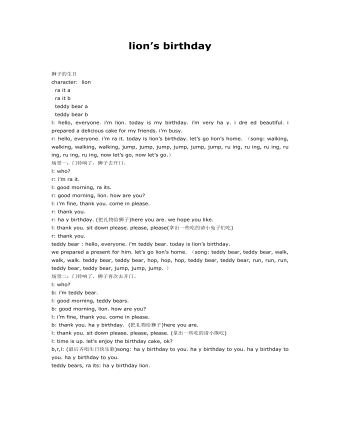
大班英语教案:lion’s birthday
场景一:门铃响了,狮子去开门。 l: who? r: i’m ra it. l: good morning, ra its. r: good morning, lion. how are you? l: i’m fine, thank you. come in please. r: thank you. r: ha y birthday. (把礼物给狮子)here you are. we hope youlike. l: thank you. sit down please. please, please(拿出一些吃的请小兔子们吃) r: thank you. teddy bear : hello, everyone. i’m teddy bear.today is lion’s birthday. we prepared a present for him. let’s go lion’shome. (song: teddy bear, teddy bear, walk, walk, walk. teddy bear,teddy bear, hop, hop, hop, teddy bear, teddy bear, run, run, run, teddy bear,teddy bear, jump, jump, jump. )
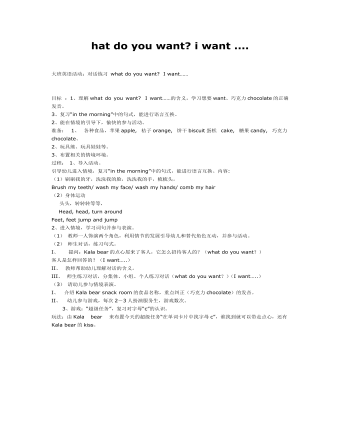
大班英语教案:hat do you want i want ....
2、玩具熊、玩具娃娃等。3、布置相关的情境环境。过程: 1、导入活动。引导幼儿进入情境,复习“in the morning”中的句式,能进行语言互换。内容:(1)刷刷我的牙,洗洗我的脸,洗洗我的手,梳梳头。Brush my teeth/ wash my face/ wash my hands/ combmy hair(2)身体运动 头头,转转转等等, Head, head, turn aroundFeet, feet jump and jump 2、进入情境,学习词句并参与表演。(1)教师一人饰演两个角色,利用情节的发展引导幼儿和替代角色互动,并参与活动。
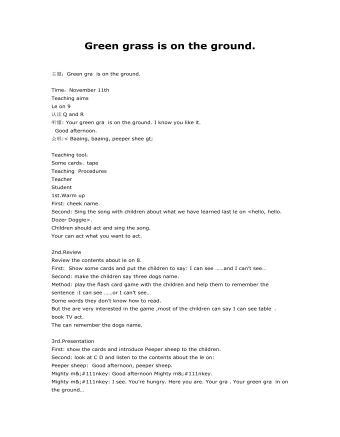
大班英语教案:Green grass is on the ground.
会唱:< Baaing, baaing,peeper shee gt; Teaching tool:Some cards、tape Teaching Procedures Teacher Student 1st.Warm up First: cheek name. Second: Sing the song with children about what we have learned last le on<hello, hello. Dozer Doggie>. Children should act and sing the song. Your can act what you want to act.
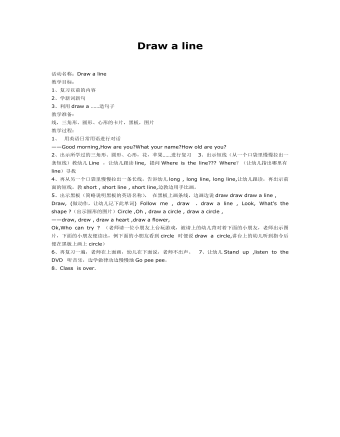
大班英语教案:Draw a line
教学目标: 1、复习以前的内容 2、学新词新句 3、利用draw a ……造句子 教学准备: 线,三角形、圆形、心形的卡片,黑板,图片 教学过程: 1、 用英语日常用语进行对话 ——Good morning,How are you?What your name?How oldare you? 2、出示所学过的三角形、圆形、心形,花,苹果……进行复习 3、出示短线(从一个口袋里慢慢拉出一条短线)教幼儿Line ,让幼儿跟读line, 提问Where is the line??? Where?(让幼儿指出哪里有line)寻找 4、再从另一个口袋里慢慢拉出一条长线,告诉幼儿long , long line, long line,让幼儿跟读,再出示前面的短线,教short , short line , shortline,边教边用手比画。
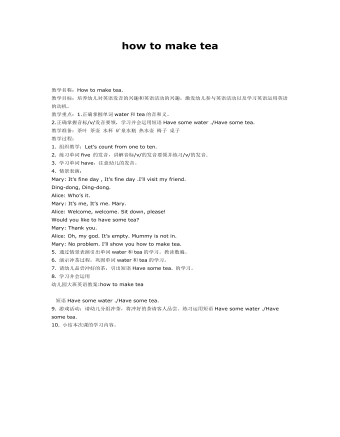
大班英语教案:how to make tea
2.正确掌握音标/v/发音要领,学习并会运用短语Have some water ./Have some tea.教学准备:茶叶茶壶水杯矿泉水瓶热水壶椅子桌子教学过程:1. 组织教学:Let’s count from one toten.2. 练习单词five 的发音,讲解音标/v/的发音要领并练习/v/的发音.3. 学习单词have,注意幼儿的发音。
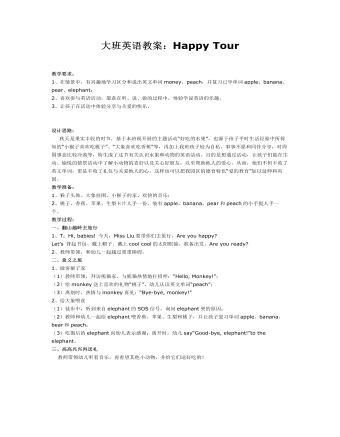
大班英语教案:Happy Tour
教学准备:1、猴子头饰、大象挂图、小猴子的家、欢快的音乐;2、桃子、香蕉、苹果、生梨卡片人手一份、装有apple、banana、pear和peach的小手提人手一个。教学过程:一、翻山越岭去旅行 1、T:Hi, babies! 今天,MissLiu要带你们去旅行,Are you happy?Let’s 背起书包、戴上帽子、戴上cool cool的太阳眼镜,准备出发,Are you ready?2、教师带领,和幼儿一起越过重重障碍。
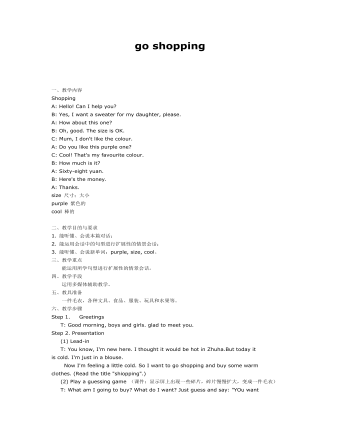
大班英语教案:go shopping
二、教学目的与要求1. 能听懂、会说本篇对话; 2. 能运用会话中的句型进行扩展性的情景会话; 3. 能听懂、会说新单词:purple, size, cool。三、教学重点 能运用所学句型进行扩展性的情景会话。四、教学手段 运用多媒体辅助教学。五、教具准备 一件毛衣,各种文具、食品、服装、玩具和水果等。
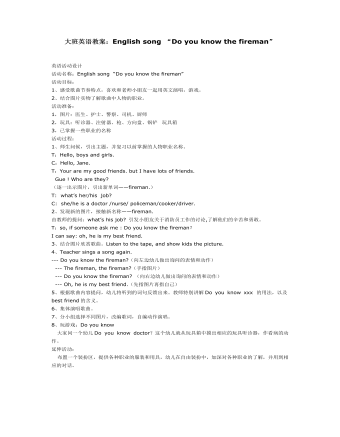
大班英语教案:English song “Do you know the fireman”
活动目标: 1、感受歌曲节奏特点,喜欢和老师小朋友一起用英文演唱,游戏。 2、结合图片实物了解歌曲中人物的职业。 活动准备: 1,图片:医生、护士、警察、司机、厨师 2,玩具:听诊器、注射器、枪、方向盘、锅铲 玩具箱 3,已掌握一些职业的名称 活动过程: 1、师生问候,引出主题,并复习以前掌握的人物职业名称。 T:Hello, boys and girls. C:Hello, Jane. T:Your are my good friends.but I have lots of friends. Gue ! Who are they? (逐一出示图片,引出新单词——fireman.) T: what’s her/his job? C: she/he is a doctor /nurse/policeman/cooker/driver.
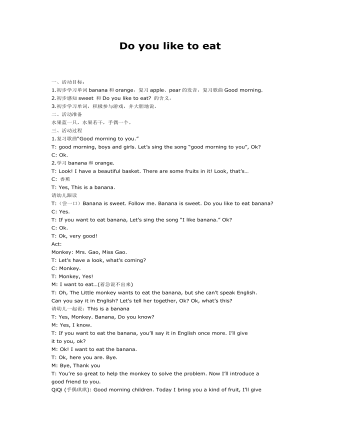
大班英语教案:Do you like to eat
二、活动准备水果蓝一只,水果若干,手偶一个。三、活动过程1.复习歌曲“Good morning to you.”T: good morning, boys and girls. Let’s sing the song“good morning to you”, Ok?C: Ok.2.学习banana和orange.T: Look! I have a beautiful basket. There are somefruits in it! Look, that’s…C: 香蕉T: Yes, This is a banana.请幼儿跟读T:(尝一口)Banana is sweet. Follow me.Banana is sweet. Do you like to eat banana?C: Yes.T: If you want to eat banana, Let’s sing the song“I like banana.” Ok?C: Ok.T: Ok, very good!Act:Monkey: Mrs. Gao, Miss Gao.T: Let’s have a look, what’s coming?C: Monkey.T: Monkey, Yes!M: I want to eat…(着急说不出来)
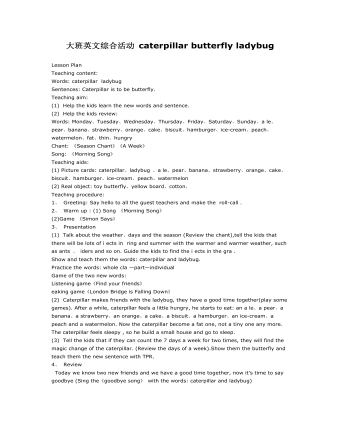
大班英语教案:caterpillar butterfly ladybug
(1) Helpthe kids learn the new words and sentence. (2) Help the kids review: Words: Monday、Tuesday、Wednesday、Thursday、Friday、Saturday、Sunday、a le、pear、banana、strawberry、orange、cake、biscuit、hamburger、ice-cream、peach、watermelon、fat、thin、hungry Chant: 《Season Chant》《A Week》 Song: 《Morning Song》 Teaching aids: (1) Picture cards: caterpillar、ladybug 、a le、pear、banana、strawberry、orange、cake、biscuit、hamburger、ice-cream、peach、watermelon (2) Real object: toy butterfly、yellow board、cotton. Teaching procedure:
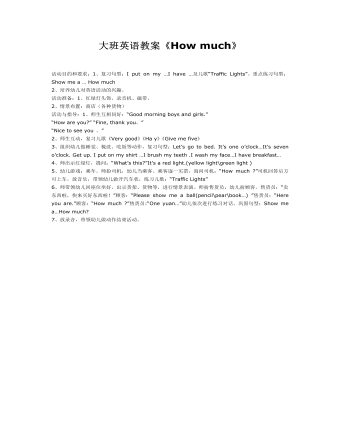
大班英语教案《How much》
2、培养幼儿对英语活动的兴趣。 活动准备:1、红绿灯头饰。录音机、磁带。 2、情景布置:商店(各种货物) 活动与指导:1、师生互相问好:“Good morning boys andgirls.” “How are you?” “Fine, thank you。” “Nice to see you 。” 2、师生互动,复习儿歌《Very good》《Ha y》《Give me five》 3、组织幼儿做睡觉、梳洗、吃饭等动作,复习句型:Let’s go to bed. It’s oneo’clock…It’s seven o’clock. Get up. I put on my shirt …I brush my teeth .I washmy face…I have breakfast…
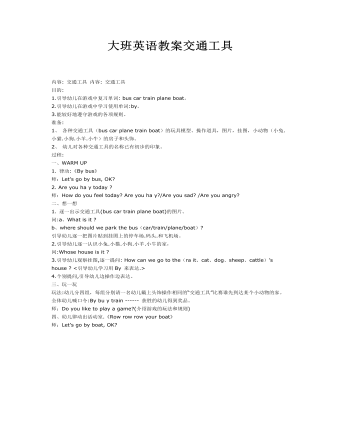
大班英语教案交通工具
目的: 1.引导幼儿在游戏中复习单词: bus car train planeboat。 2.引导幼儿在游戏中学习使用单词:by。 3.能较好地遵守游戏的各项规则。 准备: 1、各种交通工具(bus car plane train boat)的玩具模型、操作道具,图片,挂图,小动物(小兔.小猫.小狗.小羊.小牛)的房子和头饰。 2、幼儿对各种交通工具的名称已有初步的印象。 过程: 一、WARM UP 1. 律动:《By bus》 师:Let’s go by bus, OK? 2. Are you ha y today ? 师:How do you feel today? Are you ha y?/Areyou sad? /Are you angry?
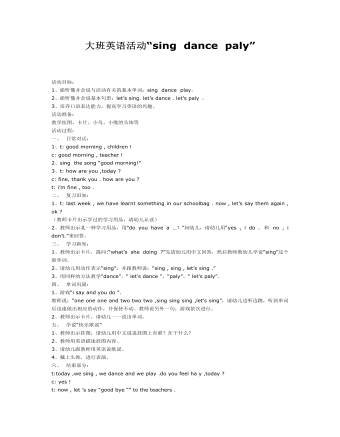
大班英语教案:“sing dance paly”
2、能听懂并会说基本句型:let’s sing. let’s dance .let’s paly 。 3、培养口语表达能力,提高学习英语的兴趣。 活动准备: 教学挂图、卡片、小鸟、小熊的头饰等 活动过程: 一、 日常对话: 1、t: good morning , children! c: good morning , teacher ! 2、sing the song “goodmorning!” 3、t: how are you ,today? c: fine, thank you . how are you ? t: i’m fine , too . 二、 复习旧知: 1、t: last week , we havelearnt something in our schoolbag . now , let’s say them again , ok ? (教师卡片出示学过的学习用品,请幼儿认读) 2、教师出示某一种学习用品,用“do you have a …?”问幼儿,请幼儿用“yes , i do . 和 no , i don’t.”来回答。
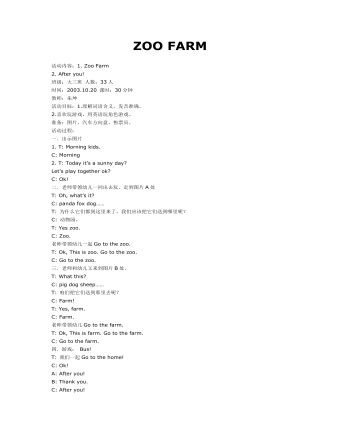
大班英语教案:ZOO FARM
2. After you! 班级:大三班人数:33人 时间:2003.10.20 课时:30分钟 教师:朱坤 活动目标:1.理解词语含义,发音准确。 2.喜欢玩游戏,用英语玩角色游戏。 准备:图片、汽车方向盘、售票员。 活动过程: 一.出示图片 1. T: Morning kids. C: Morning 2. T: Today it’s a sunny day? Let’s play together ok? C: Ok! 二.老师带领幼儿一同出去玩。走到图片A处 T: Oh, what’s it? C: panda fox dog…… T: 为什么它们都到这里来了,我们应该把它们送到哪里呢? C: 动物园。 T: Yes zoo. C: Zoo. 老师带领幼儿一起Go to the zoo. T: Ok, This is zoo. Go to the zoo. C: Go to the zoo.
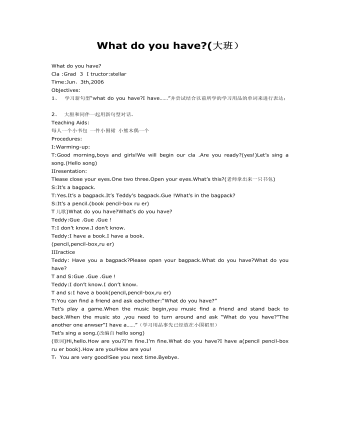
大班英语教案:What do you have
1、 学习新句型“what do you have?I have……”并尝试结合以前所学的学习用品的单词来进行表达; 2、 大胆和同伴一起用新句型对话。 Teaching Aids: 每人一个小书包一件小围裙小熊木偶一个 Procedures: I:Warming-up: T:Good morning,boys and girls!We will begin ourcla .Are you ready?(yes!)Let’s sing a song.(Hello song) IIresentation: Tlease close your eyes.One two three.Open youreyes.What’s this?(老师拿出来一只书包) S:It’s a bagpack.
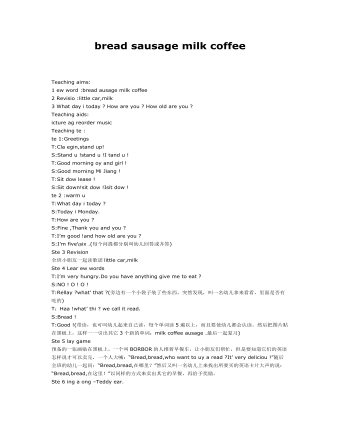
大班英语教案:bread sausage milk coffee
2 Revisio :little car,milk3 What day i today ? How are you ? How old are you ?Teaching aids:icture ag reorder musicTeaching te :te 1:GreetingsT:Cla egin,stand up!S:Stand u !stand u !I tand u !T:Good morning oy and girl !S:Good morning Mi Jiang !T:Sit dow lease !

大班英语教案:A family of chicken
活动准备: 1.Chicken头饰、鸡蛋(均人手一份) 2.cock(由教师扮演)hen (由大班幼儿扮演) 3.音乐《Mother hen》 4.草丛、篮筐(2个)活动过程: 一.唱歌念儿歌,组织教学.1. T: Come on Babies! Lets sing some songs, are you ready?2. 复习单词cock、chicken、henT: Look! (教师带上cock头饰) Who am I? (cock)T: Yes, I am cock..T: 谁想做我的宝宝chicken? (帮每位托儿带上chicken头饰)T:(亲亲抱抱cock) Who are you?(chicken)3. Rhyme:《A family of chicken》发现hen 不在Chicken chicken, ji ji jiCock cock, wo wo woHen hen, guoguoda guoguoda
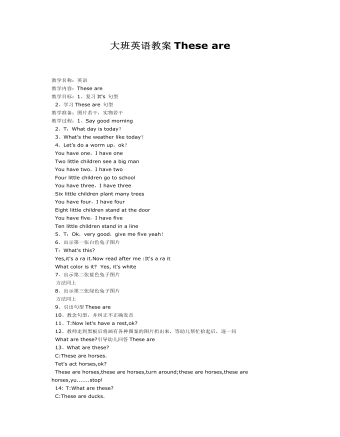
大班英语教案These are
2、学习These are 句型 教学准备:图片若干,实物若干 教学过程:1、Say good morning 2、T:What day is today? 3、What’s the weather like today? 4、Let’s do a worm up,ok? You have one,I have one Two little children see a big man You have two,I have two Four little children go to school You have three,I have three Six little children plant many trees You have four,I have four Eight little children stand at the door You have five,I have five Ten little children stand in a line
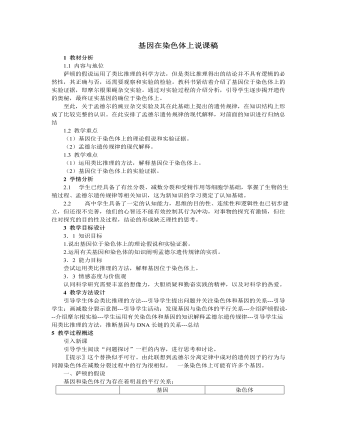
人教版高中生物必修2基因在染色体上说课稿
三、孟德尔遗传规律的现代解释①分离定律:在杂合体的细胞中,位于一对同源染色体上的等位基因,具有一定的独立性;在减数分裂形成配子的过程中,等位基因随同源染色体的分开而分离,独立地随配子遗传给后代。②自由组合定律:位于非同源染色体上的非等位基因的分离或组合是互不干扰的;在减数分裂过程中,同源染色体的等位基因彼此分离的同时,非同源染色体上的非等位基因自由组合。总结:再次强调孟德尔遗传定律的现代解释课堂练习:书本31页6、教学反思:本节课设置了一系列问题情境,层层设问,在学生答问、质疑、讨论过程中让学生建构新概念和新的知识体系,并通过教师及时掌握反馈信息,适时点拨、调节,让学生在推理判断中培养良好的思维习惯和对知识的迁移能力,而且通过留出一定的时间让学生提问,体现了以学生为主体的思想。
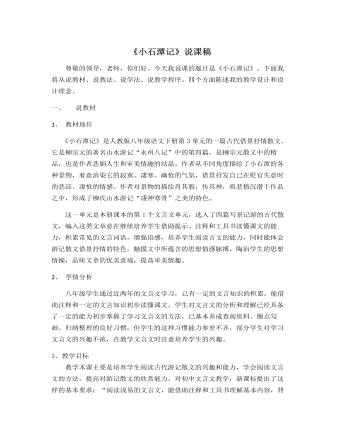
部编版语文八年级下册《小石潭记》说课稿
同学们,今天我们一起来认识一位文化名人。他因长期的贬谪生活,使他的内心十分郁闷,因此,他寄情山水,写下了著名的山水游记《永州八记》。他就是——柳宗元。余秋雨先生曾这样评价柳宗元,他说:“灾难也给了他一份宁静,使他有了足够的时间与自然相晤,与自我对话!”今天,就让我们一同走进柳宗元,走进他的《小石潭记》。(因为这段导语不仅提示了写作背景、文章内容,暗示了作者情感,能为学生学课文作背景、情感铺垫,而且语言很有吸引力,余秋雨的深情评述,易感染学生。导入语亲切,像导游一样引领学生饶有兴趣地进入文本。)(二)朗读、感知、品悟古人云:“三分诗文七分读”。文言文教学应重视积累、感悟和熏陶。要达到这一目的,最有效的手段是诵读。所以这节课我设计了四个朗读环节。(设计意图:在多重对话中理解文本:学生通过四个层次的朗读、品味语言和文本进行对话;通过体味柳宗元情怀与作者进行对话;通过有创见性地探究与生活进行对话;通过合作、交流、分享实现师生、生生之间的对话,在多重对话中达成教学目标。)

